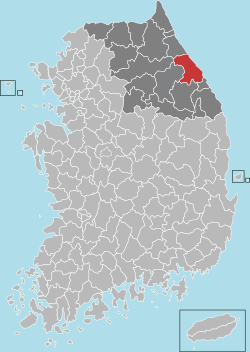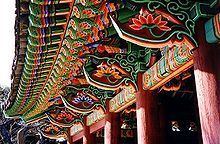Gangneung
Gangneung
강릉 | |
|---|---|
| Korean transcription(s) | |
| • Hangul | 강릉시 |
| • Hanja | 江陵市 |
| • Revised Romanization | Gangneung-si |
| • McCune-Reischauer | Kangnŭng-si |
 | |
|
Official logo of Gangneung Emblem of Gangneung | |
 Location in South Korea | |
| Country | |
| Region | Gwandong |
| Administrative divisions | 1 eup, 7 myeon, 13 dong |
| Area | |
| • Total | 1,040 km2 (400 sq mi) |
| Population (2006) | |
| • Total | 229,869 |
| • Density | 221/km2 (570/sq mi) |
| • Dialect | Gangwon |
Gangneung is a city in Gangwon-do, on the east coast of South Korea. It has a population of 229,869 (as of 2006).[1] Gangneung is the economic centre of the Yeongdong region of Gangwon Province. Gangneung has many tourist attractions, such as Jeongdongjin, a very popular area for watching the sun rise. There is a ROK airbase south of downtown Gangneung which formerly doubled as a civil airport.[2]
The city is also home to National League soccer club Gangneung City FC and K-League soccer team Gangwon FC.
Symbols of Gangneung
The flag of the city shows a red sun in the centre and blue wave in front, on a white background. The sun represents the sunrise, the wave the sea. The flower of the city is the crepe myrtle, the tree of the city is the pine tree, its bird the swan. The animal of Gangneung is the tiger.[3]
Gyeongpodae

Gangneung is considered special in that it has both access to a lake and the sea. Gyeongpodae is a pavilion overlooking a Gyeongpo lake. It is said that one can see the moon five times when at Gyeongpodae. One sees the moon once in the sky, once reflected in the lake, once reflected in the sea, once reflected in the drinking glass, and once more in the eyes of a lover. The site of Gyeongpodae is known for its location east of the centre of the city.[4]
Inside the Gyeongpodae pavilion, built with 28 pillars, is the Gyeongpodaebu, a poem by Yul Gok. Gyeongpodaebu describes the movement of the heavens and the moon. The best view of the moon is on the 15th of the lunar month.[4]
Sunrise
Sunrises, especially the first in the New Year, are important in traditional Korean culture. The Jeongdongjin and Gyeongpo beaches in Gangneung are popular places to enjoy a sunrise.[5]
Culture
Gangneung has numerous festivals. The biggest and most famous is the Gangneung Dano Festival (강릉단오제) at the Dano fairground near the Namdae River. In 1967, the Gangneung Dano Festival was designated Korean National Immaterial Cultural Heritage No. 13. On November 11, 2005 it was designated by UNESCO as a "Masterpieces of the Oral and Intangible Heritage of Humanity". Nowadays, it is a combination of several commemoration rites and traditional plays. A highlight is the traditional Gwanno Mask Dance (Gwanno Gamyeongeuk) which is only performed at this festival.
In addition to well established festivals like the Dano, there are several newer festivals in Gangneung, such as the IJAF (International Junior Art Festival) enjoys great popularity. The IJAF is a cultural festival for youth from all over the world. The festival includes both performances of the participating groups and a diversified cultural program demonstrating the essence of Korean culture. Since 2002, the IJAF takes place at Gyeongpo Beach in the end of July. Also, the Gyeongpo Rock Festival was established in 2006. This festival, mostly attracting young people, offers young Korean bands from the Gangneung area a stage for their performances.
There are a number of historical remains and museums in Gangneung. The most prominent being the Ojukheon Museum, which is named after a special black bamboo growing in this area. It is the birthplace of the famous Korean scholar Yulgok (1536–1584) (whose image is on the South Korean 5,000 Won note) and his mother Saimdang (1504–1551) (whose image is on the 50,000 Won note.) In 1963, the Ojukheon Museum was designated as National Cultural Heritage No. 165. It includes one of the oldest wooden buildings in Korea. Several shrines and old residential buildings deliver insight into the lives of these famous Koreans. Next to the Ojukheon Museum there is the Gangneung Municipal Museum which shows folklore and antique pieces from the history of the city. Located in the hills surrounding Gangneung City, there is the revealing Daegwallyeong Museum. It consists of a private collection with more than 1000 artifacts and shows the agricultural history of the region.
Climate
Gangneung experiences a humid subtropical climate (Köppen Cfa) with cool to cold winters and hot, humid summers.
| Climate data for Gangneung (1981−2010) | |||||||||||||
|---|---|---|---|---|---|---|---|---|---|---|---|---|---|
| Month | Jan | Feb | Mar | Apr | May | Jun | Jul | Aug | Sep | Oct | Nov | Dec | Year |
| Mean daily maximum °C (°F) | 5.0 (41.0) |
6.7 (44.1) |
10.9 (51.6) |
17.9 (64.2) |
22.4 (72.3) |
24.9 (76.8) |
27.8 (82.0) |
28.3 (82.9) |
24.5 (76.1) |
20.3 (68.5) |
13.7 (56.7) |
7.9 (46.2) |
17.5 (63.5) |
| Daily mean °C (°F) | 0.4 (32.7) |
2.2 (36.0) |
6.3 (43.3) |
12.9 (55.2) |
17.6 (63.7) |
20.8 (69.4) |
24.2 (75.6) |
24.6 (76.3) |
20.3 (68.5) |
15.5 (59.9) |
9.2 (48.6) |
3.4 (38.1) |
13.1 (55.6) |
| Mean daily minimum °C (°F) | −3.2 (26.2) |
−1.6 (29.1) |
2.0 (35.6) |
7.9 (46.2) |
12.9 (55.2) |
17.0 (62.6) |
21.1 (70.0) |
21.5 (70.7) |
16.6 (61.9) |
11.2 (52.2) |
5.3 (41.5) |
−0.3 (31.5) |
9.2 (48.6) |
| Average precipitation mm (inches) | 55.1 (2.17) |
49.6 (1.95) |
68.9 (2.71) |
68.7 (2.70) |
87.0 (3.43) |
120.6 (4.75) |
242.8 (9.56) |
298.9 (11.77) |
243.8 (9.60) |
110.4 (4.35) |
80.3 (3.16) |
38.3 (1.51) |
1,464.5 (57.66) |
| Average precipitation days (≥ 0.1 mm) | 5.8 | 6.4 | 8.9 | 8.3 | 9.3 | 11.3 | 15.6 | 15.6 | 11.1 | 7.1 | 7.2 | 4.5 | 111.1 |
| Average relative humidity (%) | 49.0 | 52.1 | 56.6 | 54.1 | 61.1 | 71.4 | 76.6 | 78.1 | 74.3 | 62.2 | 53.8 | 47.8 | 61.4 |
| Mean monthly sunshine hours | 183.8 | 172.6 | 186.5 | 203.8 | 209.1 | 165.0 | 138.2 | 147.9 | 157.2 | 188.3 | 170.6 | 183.3 | 2,106.3 |
| Source: Korea Meteorological Administration[6] | |||||||||||||
2018 Winter Olympics
The city will be the venue for the indoor sports of the 2018 Winter Olympics in Pyeongchang. All these facilities, except for the Gangneung Indoor Ice Rink will be newly built for the Olympics.
- Gangneung Indoor Ice Rink – Curling
- Gangneung Kwandong University Arena – Ice Hockey
- Gangneung Science Oval – Speed Skating
- Gyeongpo Ice Hall – Short track speed skating and Figure skating
- Union Hockey Centre – Ice Hockey (temporary)
Gallery
-
The birth house of Heo Nanseolheon, a famous Korean poet of 17th century.
-
The birthplace of Yul Gok.
-
Seongyojang, a country house built and owned by a prominent yangban family in Gangneung. Built in 19th century.
-
A closer view at Seongyojang.
Sister cities
 Gangseo-gu, Seoul since February 26, 2004
Gangseo-gu, Seoul since February 26, 2004 Seo-gu, Daejeon since May 25, 2004
Seo-gu, Daejeon since May 25, 2004 Bucheon, Gyeonggi-do since July 6, 2004
Bucheon, Gyeonggi-do since July 6, 2004 Buk-gu, Daegu since October 29, 2004
Buk-gu, Daegu since October 29, 2004 Seocho-gu, Seoul since March 23, 2006
Seocho-gu, Seoul since March 23, 2006 Chichibu, Saitama since February 16, 1983
Chichibu, Saitama since February 16, 1983 Jiaxing, Zhejiang Province since May 11, 1999
Jiaxing, Zhejiang Province since May 11, 1999 Chattanooga, Tennessee since October 30, 2003
Chattanooga, Tennessee since October 30, 2003 Jingzhou, Hubei Province since October 19, 2004
Jingzhou, Hubei Province since October 19, 2004 Irkutsk, Irkutsk Oblast since 2009
Irkutsk, Irkutsk Oblast since 2009
See also
External links
References
- ^ Gangneung City (2003). Population & Households. Retrieved January 14, 2006.
- ^ US Forces Korea (2004). Alphabetical Listing. Retrieved January 14, 2006.
- ^ Gangneung City (2003). Symbols. Retrieved January 14, 2006.
- ^ a b Korea Tourism Organization (2005). Gyeongpodae. Retrieved January 14, 2006.
- ^ Best spots to usher in the New Year (2009) Korea Herald Retrieved June 23. 2010.
- ^ "평년값자료(30년) 강릉(105)". Korea Meteorological Administration. Retrieved 2011−04−30.
{{cite web}}: Check date values in:|accessdate=(help)





